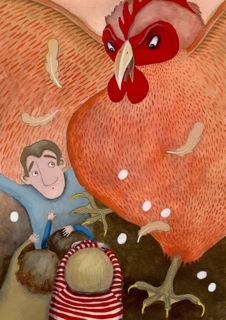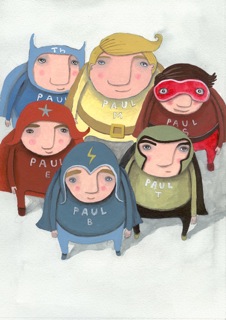|
Paul Bird, The Secret of the Stones and One Mad Rooster, extracts‘Zeke looked around him. Ahead, seemingly for miles, stretched rows and rows of books—shelf upon shelf, layer upon layer, rising as high and as far as the eye could see. He stepped forward and the floor creaked beneath him. As he looked down, he saw polished floorboards and, stretching along the vast walls, leather couches and seats with small green reading lamps. There were the familiar scents of wood and leather and the musty smell of an old library. “Very interesting,” said Odin. “I have never seen the library like this before.” “What do you mean?” asked Zeke. “The library is a living thing. It tunes in as the user enters and will alter itself so that the user feels comfortable. This image of a library must be one that you are very comfortable with, Zeke.” “It reminds me of an old library I used to visit with my grandfather,” he said. “We used to visit there every holiday. It was never as big as this, though.” “Of course.” said Odin. “The library has attempted to make you comfortable by reworking that memory and adapting it.” Zeke moved forward. Apart from the size, the library felt like the old place in Tenterfield that he had visited when he was much younger. He approached one of the shelves and reached out to touch the books. His hand went through them, and he realised that they were not real. They were images, projections, somehow made to look as if they were books. “So it’s all fake?” said Zeke. “None of it is real at all.” He was a little disappointed. “On the contrary, Zeke, it is very real. What you see is the library’s attempt to make you so comfortable that you will use it. But you don’t need to move to a shelf to find a book. You need only stand here and think and the information will come to you.” “But could I walk all the way to the end?” asked Zeke. “Of course,” said Odin. “The space itself is not an illusion, only the way that the information has been displayed. This space is very real.” “But I don’t understand,” said Zeke. “Why has it changed to suit me? And what if there were three or four hundred people in there? Then what would it look like?” “The user sees what he or she wants to see,” said Odin. “I can see how you perceive the library because I’m linked to your thoughts. When you come to the library, this is what you will see. But if your brother or sister were with you, they might see something different. Come—let me show you how it works.” Odin led him to a large sloping wooden desk and motioned for him to stand in front of it. “In this library, we have the entire history of the three peoples. We have also gathered important histories and other works from others on this planet. All you have to do is think of what you want to see, and it will appear.” Zeke thought for a moment. He did not want to embarrass himself by getting a comic to appear or some random book that he had been reading at school. Instead, he thought of something that his father had told him about and that he had looked at once. In a moment, a large book appeared in front of him. “Hamlet. An interesting choice, Zeke.” ’
|
||
|
One Mad RoosterPaul tells how he came to write his stories:I grew up in Newcastle and spent much of my spare time making up adventures at the nearby creek and swamp. Most were based around yarns that my parents had told me about their childhood. These tales kept us enthralled. They told of a time when things were so different and exciting. They were part of our history, but as time went on I was sad to see that they became dim memories, fragmented through time and neglect. After I moved to Sydney in 1999, I started writing again. Determined not to allow the stories to fade, I kept a diary and pencil in my bag, using any spare moment to write. But the stories stayed in that diary, needing a reason to emerge. That reason came with laugh-out-aloud car trips with my wife and family, as we recounted adventures from our childhoods. My children loved hearing them, just as I had loved listening to my parents’ stories. Now I had a reason to write...
‘When I was in Primary School there were six boys named Paul in my class. Paul was a popular name back then, in honour of Saint Paul, and mothers and fathers hoped that their children so named would exhibit some of the unique virtues and qualities of the great Christian missionary and teacher. Unfortunately, they were largely disappointed—but we tried our best. So many boys with the same name presented big problems. If a teacher called “Paul!”, he or she got five responses simultaneously. This created enormous confusion as well as a lot of noise, as six Pauls responded loudly…To fix this problem, our teachers referred to us by our first name plus the first letter of our second name…this worked pretty well. My name was Paul B, and the others were Paul T, Paul S, Paul Th, Paul M and Paul E. Each of us had minor super powers. We could all do something unique that was special to us alone and hence we felt it was reasonable that these be referred to as super powers. Not fantastic super powers, like flying, super strength or web spinning, but mild super powers, super sometimes only in the minds of your mates. For example, Paul S could impersonate any teacher in the whole school. He could make his voice so convincing that you would swear that Sister De Porres was just around the corner, ready to spring us doing something she had told us not to do. Sister De Porres was the school principal. We all called her DP for short. She was mighty scary and her cry could be heard from one side of the school ground to the other. Paul E could do super-fast underarm farts that rose higher and higher, eventually squealing as they reached a high pitch. He had a fantastic ability to let one go just as the teacher had turned her back to write on the chalkboard, and then sit innocently, as if nothing had happened. Paul M could jump further than anyone in the whole school. Everyone wanted him on their team. Paul T had super strength; he could lift huge rocks and bits of wood. He was also a very good fighter, handy to have around if there was trouble. Paul Th was very good with his feet. He had an uncanny ability with a soccer ball and could balance on the tiniest of objects. For my part, I could read minds…’ (from Six Pauls and One Peter) |



